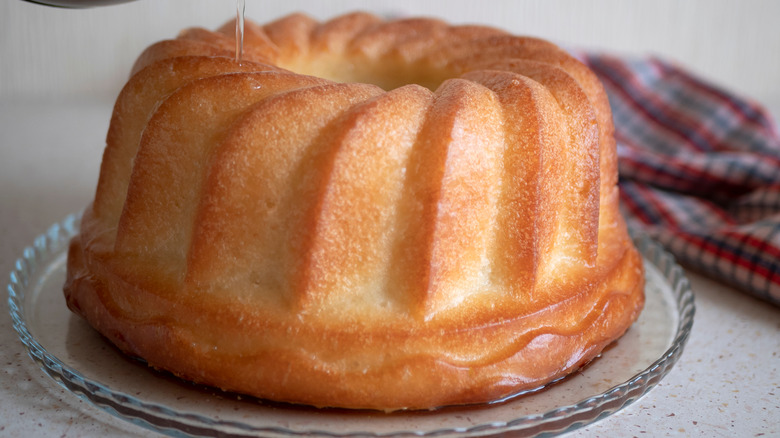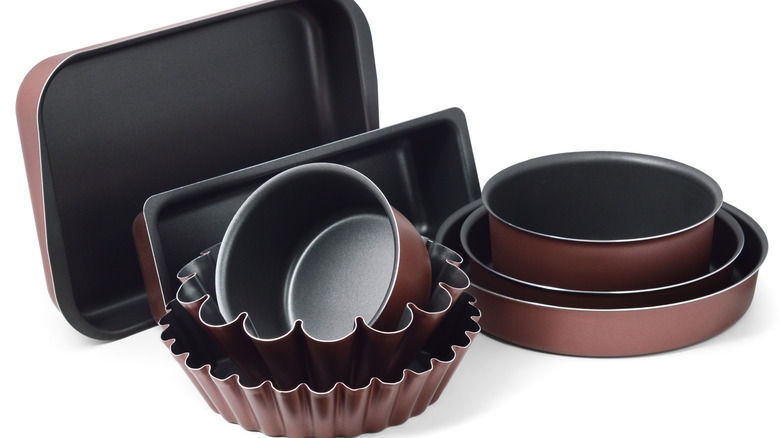The Secret To Greasing Cake Pans
We may receive a commission on purchases made from links.
You've just created a masterpiece — a luscious cake made from the finest ingredients, baked to perfection. Yes, this is going to be the most beautiful dessert creation your guests have ever seen. If only you could dislodge it from the pan. If you have ever found yourself making fruitless attempts to remove a stubborn baked good from a cooking vessel, you know how frustrating it can be. Expletives have been tossed about and foreheads deeply furrowed. And your ire is only worsened by the fact that this could have been avoided.
Yes, there are a number of ways to keep your cake of the bundt, sponge, pound, or other variety from taking up permanent residence in its cake pan. Cookbook author Joy Wilson tells Martha Stewart the key is having a "layer of fat in between a metal pan and gluten and sugar," in order to prevent it from sticking. Betty Crocker advises using butter as that layer of fat, spreading it all over the inside of the pan. Follow this with a dusting of flour that coats the inside evenly. This commonly used technique may have liberated your angel food cake with little-to-no effort at all, but this is not the only way to avoid cakes that refuse to be dislodged.
Cake goop is perfect for greasing cake pans
Blogger and cookbook author Jocelyn Delk Adams recommends using her homemade cake release (aka "cake goop"), a three-ingredient concoction that enables her cakes to be perfectly shaped and free from unsightly flour stains. Mix together equal parts flour, vegetable oil, and shortening (she uses 1 cup of each), and thoroughly coat your cooking vessel. She adds that the leftover goop can be stored in an airtight container in the fridge for up to six months.
TikTok user Colin Farquhar offers a similar solution for creating the ultimate chocolate cake. He uses his signature chocolate goop to create easy-to-release chocolate baked goods that look fabulous every time. He blends a slurry of 1 tablespoon cocoa powder, 2 tablespoons vegetable oil, and 2 tablespoons shortening. According to his video, you apply a thick layer to the inside of your cake pan, and "it will not leave any residue at all." Easy, right?
This unexpected advice may have prevented your current conundrum, but there is another pan-greasing trick that may also work.
There is also a little-known sugar technique
Whatever you do, don't make the mistake of assuming that nonstick pans will eliminate this problem. They won't. According to MasterClass, nonstick pans still require greasing. They also warn that you mustn't forget the inner corners.
If you'd like to try out a relatively unknown way of coating your bakeware, Food52 offers up a novel idea. Sugar! Yes, according to the outlet, you can grease your pan if you coat it in sugar. And, if you're concerned that the sugar will create a caramelized sticky mess, they say you need not worry. In their attempts, the sugar proved to coat more evenly than flour, and it left behind a crunchy crust that was super-easy to frost. Yes, even your thickest peanut butter frosting recipe won't disturb this hearty surface.
While it's too late to liberate your current cake, these techniques may save future baked projects from welding themselves to the pan. And, if Colin Farquhar's enthusiasm is anything to go by, creating cake goop — chocolate or otherwise — looks enjoyable in itself.


